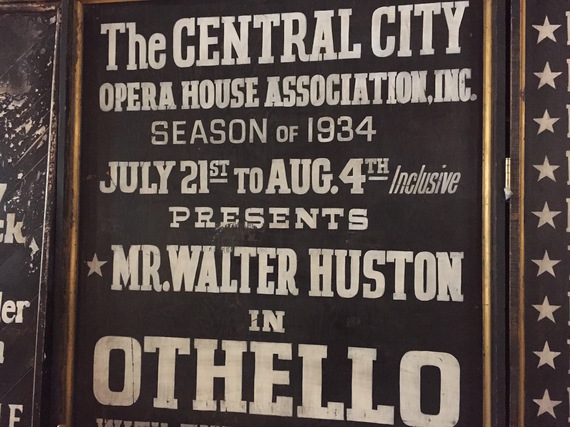I write from the swing on the small front porch of my quaint house with a white picket fence. The view is of an old mining town. My dog, Charlie, lies sprawled in the sun. No, this is not a vacation. I am working in Central City, Colorado (population 724) for the summer with Central City Opera. The town is located west of Denver off of Interstate 70 at an altitude of 8500 feet. Thankfully we have had a three week rehearsal period to get adjusted to the lack of oxygen.
We perform in an opera house built in 1878, located in the National Historic Landmark District of this small former mining town. This week we will perform Douglas Moore's The Ballad of Baby Doe, celebrating the 60th anniversary of the opera's premiere which happened in this very place. The opera takes place in Leadville, Denver and Washington D.C. and is based on the real-life story of Elizabeth "Baby" Doe, Horace Tabor the silver baron, and his wife Augusta Pierce Tabor. I play Augusta, the wife who was the first white woman in Idaho Springs CO (just down the road) and who lived in tents and was a true pioneer woman behind the man, who will be left by Horace for the younger Baby Doe. At one time Horace was one of the wealthiest men in the country and he also was Lt. Governor of Colorado and a Senator. He was stubbornly sure of the silver market and lost nearly everything once the country turned to the gold standard. Baby Doe stayed loyal throughout and lived in poverty on the mine property he once owned until her death from exposure. Augusta died a regretful but wealthy old woman.
The performances are why I am here but what fascinates me, and what people might like to know, is about the existence of a company which has thrived since 1932. Central City Opera is the fifth oldest opera company in the United States (after the Metropolitan Opera, Cincinnati Opera, San Francisco Opera and Chautauqua Opera) and it is the second oldest summer opera company (following Chautauqua Opera).
The opera house's early glory years were short-lived. When the Central City mines were played out, the Opera House fell into disrepair. I have heard that there were even donkeys being housed in it. Fortunately, a volunteer-driven effort led to an extensive restoration of the Opera House in 1932. That summer, the legendary actress Lillian Gish opened the newly restored opera house with Camille, launching an annual tradition of summer festivals in Central City that continues to this day.
Early festivals featured both opera and theater; more recently, the six-week festival has been a celebration of traditional and progressive works. In addition to Lillian Gish, other stars of the opera and stage have performed in the Central City summer festivals, including Beverly Sills, Jerome Hines, Helen Hayes, Samuel Ramey. The walls and halls of the dressing rooms are lined with photos of all the performers through the years.
One of the things that immediately stood out to me when I arrived were the many buildings with the Primrose Flower plaques that indicate that Central City Opera owns and maintains 28 other historic buildings, including 25 residences, built in Central City between 1860 and 1900. These properties have been the Association's responsibility since 1932. They house company operations, performers and technicians during the summer opera festival. What great forethought.
Our preliminary staging rehearsals in an old building that was formerly a foundry. It has been charmingly restored keeping aspects of the old original building.
The rehearsal rooms are filled with the original placards from years past.
Up the road is a derelict cemetery with graves from the mining days which really puts one into the mindset of those days while the town itself is surrounded by derelict mines that have just been left as they were. I might add that even in the yards of many homes there are still dilapidated outhouses.
The company also has technical interns and a thriving Apprentice and Studio Artist program of quite a high level which began in 1978, the brainchild of conductor John Moriarity. These singers are assigned the smaller roles, understudying and perform their own operas later in the summer. The 10-week program integrates daily opera training in diction, movement, stage combat, acting, stage technique, individual coaching and role study; and sessions in career management with rehearsals and opera performance opportunities in the summer's main stage and additional festival productions.The program selects 30-32 participants from nearly 1,000 applicants each year. Judging from their performance in this production I would think they all have a pretty good shot at a good career. I am so impressed with their professionalism and talent.
An added bonus is greeting them as they walk by my little house.
Last but not least the company has an educational outreach component throughout the year in the Denver-Boulder area.
Central City Opera is one of those companies I would have loved to have started out in. A summer apprenticeship eluded me in my early career so I suppose I am reliving what might have been. It is nice to know places like this can still exist. It is also a welcome change from the high-pressure, big-house atmosphere. I will have 18 performances in which I can hone my craft in a new role. All involved are equals. As the sign on the cast building states, "Leave your ego at the door".


